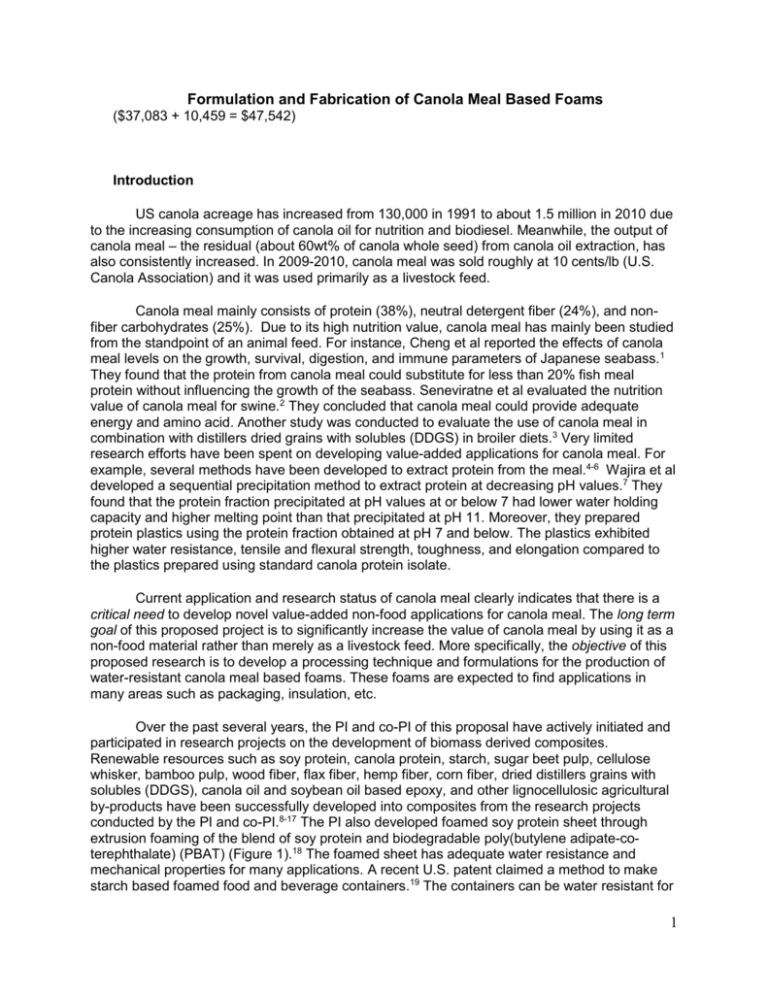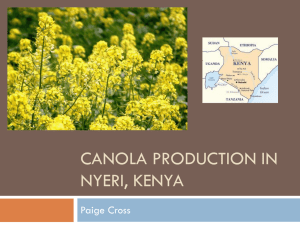Project Type: New - NDSU Agriculture
advertisement

Formulation and Fabrication of Canola Meal Based Foams ($37,083 + 10,459 = $47,542) Introduction US canola acreage has increased from 130,000 in 1991 to about 1.5 million in 2010 due to the increasing consumption of canola oil for nutrition and biodiesel. Meanwhile, the output of canola meal – the residual (about 60wt% of canola whole seed) from canola oil extraction, has also consistently increased. In 2009-2010, canola meal was sold roughly at 10 cents/lb (U.S. Canola Association) and it was used primarily as a livestock feed. Canola meal mainly consists of protein (38%), neutral detergent fiber (24%), and nonfiber carbohydrates (25%). Due to its high nutrition value, canola meal has mainly been studied from the standpoint of an animal feed. For instance, Cheng et al reported the effects of canola meal levels on the growth, survival, digestion, and immune parameters of Japanese seabass.1 They found that the protein from canola meal could substitute for less than 20% fish meal protein without influencing the growth of the seabass. Seneviratne et al evaluated the nutrition value of canola meal for swine.2 They concluded that canola meal could provide adequate energy and amino acid. Another study was conducted to evaluate the use of canola meal in combination with distillers dried grains with solubles (DDGS) in broiler diets.3 Very limited research efforts have been spent on developing value-added applications for canola meal. For example, several methods have been developed to extract protein from the meal.4-6 Wajira et al developed a sequential precipitation method to extract protein at decreasing pH values.7 They found that the protein fraction precipitated at pH values at or below 7 had lower water holding capacity and higher melting point than that precipitated at pH 11. Moreover, they prepared protein plastics using the protein fraction obtained at pH 7 and below. The plastics exhibited higher water resistance, tensile and flexural strength, toughness, and elongation compared to the plastics prepared using standard canola protein isolate. Current application and research status of canola meal clearly indicates that there is a critical need to develop novel value-added non-food applications for canola meal. The long term goal of this proposed project is to significantly increase the value of canola meal by using it as a non-food material rather than merely as a livestock feed. More specifically, the objective of this proposed research is to develop a processing technique and formulations for the production of water-resistant canola meal based foams. These foams are expected to find applications in many areas such as packaging, insulation, etc. Over the past several years, the PI and co-PI of this proposal have actively initiated and participated in research projects on the development of biomass derived composites. Renewable resources such as soy protein, canola protein, starch, sugar beet pulp, cellulose whisker, bamboo pulp, wood fiber, flax fiber, hemp fiber, corn fiber, dried distillers grains with solubles (DDGS), canola oil and soybean oil based epoxy, and other lignocellulosic agricultural by-products have been successfully developed into composites from the research projects conducted by the PI and co-PI.8-17 The PI also developed foamed soy protein sheet through extrusion foaming of the blend of soy protein and biodegradable poly(butylene adipate-coterephthalate) (PBAT) (Figure 1).18 The foamed sheet has adequate water resistance and mechanical properties for many applications. A recent U.S. patent claimed a method to make starch based foamed food and beverage containers.19 The containers can be water resistant for 1 a usable amount of time without applying any coating on their surfaces. The formulation of the container included water, starch, proteins, fibers, and crosslinking and water repellent agents. The PI is also developing foamed composite products using peas as the primary feedstock.20 Peas and their husks comprise mainly starch, cellulose fiber, protein, and other carbohydrates, all of which are biopolymers and have been shown to be useful materials for value added nonfood applications such as extruded or injection molded polymer composites. Figure 2 shows a foamed plate developed in this research. Further improvement on the technique is undergoing. (a) (b) Figure 1 Extrusion foaming of soy protein/PBAT blend (a) and the foamed sheet (b). Figure 2. A pea-based foamed plate. Canola meal comprises several constituents similar to peas, e.g. protein, fiber, and carbohydrates. However, canola meal is low in starch content. In this proposed project we hypothesize that canola meal provides the essential constituents for making a foamed biocomposite, the meal can be ground and mixed with added starch and appropriate crosslinking agent and water repellent agent, and the mixture can then be processed into water-resistant foamed composite by compression molding. This hypothesis will be objectively tested by carrying out the research plan detailed in the Approach section. 2 Objectives We propose two specific aims for this project: 1. A formulation comprising primarily canola meal and a processing method will be developed to produce canola meal based foams. The successful completion of this aim will enable us to transform canola meal into composite foams suitable for many applications. 2. The relationship of formulation-processing parameters-foam properties will be established. Accomplishing this aim will enable us to manipulate the properties of the foams according to user requirements. Rationale and Significance Current research on non-food high value applications of canola meal is still in its infancy. The only published research is on the extraction of canola protein for its nutrition value or for making plastics. However, protein extraction is a low efficient process and it requires large amount of solvents that can pose serious environment risks. Our rationale for this proposal is that, developing canola meal into composite foams using a high efficient environmentally benign procedure can significantly increases the value of canola meal and therefore would substantially benefit canola oil producers and canola growers. The proposed foams can find widespread applications in packaging, shipping and insulation, disposable food service wares, household items, etc., whose markets are currently dominated by petroleum-based plastics and expensive biodegradable plastics. Compared to using canola meal merely as an animal feed, the proposed technology imparts higher values to the meal and would bring higher profit return to the directly related parties. In a bigger context, industrial production of the foams can create new employment opportunities. Moreover, issues such as environmental protection and energy security will also be addressed through replacing petroleum-based plastics with this canola meal based products. Approach A two-phase research plan has been designed to accomplish the specific aims of the proposed research. In the first phase, the manufacturing process to produce the foamed articles will be developed. This will include the design and making of a compression mold allowing foam formation and the development of a preliminary formulation. The second phase of the plan will be focused on process refinements and formulation optimization based on property results of the produced articles. A formulation-processing-property relationship will be established for the foams. This relationship forms an essential part of the knowledge base of the canola meal based foams and serves as a guideline for property control and manipulation. The detailed explanation of the plan is given below. Phase one We recognize that there are more than one processing methods to make the proposed foams (e.g. extrusion and compression molding), each having its own advantages and disadvantages. In this research, a low cost and relatively easy process – compression molding will be used for proof-of-concept purpose. Ground canola meal powder will be dispersed in water to form a mixture. A certain amount of starch, which acts as a binder to promote product structural integrity, will be added to the mixture. Long natural fibers (from canola hull or other sources) can also be added if found necessary. The long fibers function as 3 mechanical and structural reinforcement to the composite. Cross-linking agents such as glyoxal based compounds will also be added to decrease moisture susceptibility of the starch and canola protein. If necessary, natural wax (animal, vegetable, etc) emulsion will also be included in the formulation to improve overall water resistance of the product. Natural uncured latex can be added when high toughness is required for the product. Inorganic fillers such as calcium carbonate ground powder can also be included in the formulation. The mixture will be heated and vigorously stirred and then poured into a heated compression mold. The mixture will be baked in the mold. During the process, the steam generated by heating will push the mixture to completely fill the mold cavity and a skin will form on the outer surface of the mixture after sufficient contact with the cavity surface. The mold is equipped with steam vent gaps so that under sufficient pressure excessive steam can escape through the vent gaps. The finished foam will have a dense skin with porous internal structure. A flow chart of the process is illustrated in in Figure 3. A schematic drawing of the compression mold is also shown in the figure. Canola meal Glyoxal Wax Latex Starch Fibers Mixing Compression molding Water Male half Product (a bowl) Steam vent gap Female half Figure 3. Flow chart of the manufacturing process (upper) and a schematic drawing of the compression mold (lower). Phase 2 The porous microstructure of the foams will be studied by optical microscopy (OM) and scanning electron microscopy (SEM). Pore size, size distribution, and pore density of the product will be obtained from these experiments. Thermal transitions and thermal stability of the product will be examined by differential scanning calorimeter (DSC) and thermogravimetric analysis (TGA). Tensile samples will be cut from the product and tensile strength, modulus, and strain (toughness) will be tested. These mechanical properties will be correlated to the microstructure of the product so that a structure-property relationship can be established. Moreover, the dependence of the microstructure and mechanical properties on the product formulation and processing parameters will also be determined. After these relationships are established, mechanical properties of the product can then be controlled to meet different application requirements. Water resistance of the product will be investigated by water immersion tests. Sample weight change before and after water immersion is the weight of the absorbed water. This value will be correlated to the formulation (e.g. contents of crosslinking and water repellent agents) and processing parameters. Heat resistance of the product will be tested by putting the product in an oven/vacuum oven at different temperatures for various periods of time and examining the 4 integrity of the product. These tests are important for the applications such as food service wares. Outreach/Extension Activities We plan to disseminate the knowledge obtained from this research by attending professional conferences and seminars. The knowledge will also be made available to interested parties in ND and surrounding states through North Central Canola Research Program. Moreover, the co-PI of this project, Dr. Chad Ulven, has strong collaboration with local industries. He has been working with John Deere Co., Steinwall Inc., Falcon Plastics, and BioComposites, LLC to utilize natural fiber reinforced biocomposites in their products. This close tie would be an advantage to the potential commercialization of this proposed research. REFERENCES 1. Cheng, Z.; Ai, Q.; Mai, K.; Xu, W.; Ma, H.; Li, Y.; Zhang, J. Aquaculture 2010, 305, 102. 2. Seneviratne, R. W.; Young, M. G.; Beltranena, E.; Goonewardene, L. A.; Newkirk, R. W.; Zijlstra, R. T. J. Anim. Sci. 2010, 88, 2073. 3. Min, Y. N.; Hancock, A.; Yan, F.; Lu, C.; Coto, C.; Karimi, A.; Park, J. H.; Liu, F. Z.; Waldroup, P. W. J. Appl. Poult. Res. 2009, 18, 725. 4. Ghodsvali, A.; Khodaparast, M.H.H.; Vosoughi, M.; Diosady, L.L. Food Res. Int. 2005, 38, 223. 5. Ismond, M.A.H.; Welsh, W.D. Food Chem. 1992, 45, 125. 6. Tzeng, Y.M.; Diosady, L.L.; Rubin, L.J. J. Food. Sci. 1988, 53, 1537. 7. Wajira, A. R. M.; Chang, K. C.;Ulven, C. A.; Pryor, S. W. J. Am. Oil. Chem. Soc. 2010, 87, 909. 8. Liu, B.; Jiang, L.; Liu, H., Zhang, J. Ind. Eng. Chem. Res. 2010, 49, 6399. 9. Zhang, J.; Jiang, L.; Zhu, L. Y.; Jane, J.; Mungara, P. Biomacromolecules 2006, 7, 1551. 10. Jiang, L.; Liu, B.; Zhang, J. Macromol Mater Eng 2009, 294, 301 11. Jiang, L.; Chen, F.; Qian, J.; Huang, J.; Zhang, J.; Liu, L. Ind. Eng. Chem. Res. 2010, 49, 572 12. Ten, E.; Turtle, J.; Bahr, D.; Jiang, L.; Wolcott. M. Polymer 2010, 51, 2652. 13. Fuqua, M.A.; Ulven, C.A. ASABE 2008 Annual Meeting. 14. Ulven, C.A.; Fuqua, M.A. AIChE 2008 Annual Meeting. 15. Foulk, J.A., Fuqua, M., Ulven, C., Alcock, M. J. Sustainable Eng. 2010, 3, 1. 16. Chevali, V.S.; Fuqua, M.A.; Huo, S.S.; Ulven, C.A. SAE Int. J. Mater. Manuf. 2010, 3,1221. 17. Fuqua, M.A.; Huo, S.S.; Chevali, V.S.; Ulven, C.A. SAE Int. J. Mater. Manuf . 2010, 3, 230. 18. Jiang, L.; Liu, B.; Zhang, J. manuscript in preparation. 19. Dellinger, D.; Helou, E. Jr. US patent 7,553,363 B2, 2009. 20. Sablani, S.S.; Jiang, L.; Zhang, J.W. Developing Lentil/Pea Based Biodegradable Food Service Items, 2010, Cool Season Food Legume Research Program. 5 Budget Justification Salaries Post-Doctoral Research Associate: A sum of $6667 is requested to support a PostDoctoral Research Associate for 2 months of the project. Post-Doctoral Research Associates in the Mechanical Engineering Department are provided a salary of $40,000 a year. The fringe benefit rate is 35%. Graduate Research Assistant: A sum of $19,200 is requested to support one Master graduate student over the project duration. Graduate students in the Mechanical Engineering Department are provided a salary of $1,600 a month. The fringe benefit rate is 2%. Materials and Supplies A sum of $2,000 is requested to purchase materials and supplies needed to conduct the proposed research. These include canola meal, polymer resin, chemical agents, additives, natural fibers, and other processing supplies. Manufacturing of a compression mold A simple compression mold needs to be designed and made to prepare the foamed samples. The cost is estimated to be $4,500, including possible trial and error modifications. Travel A total of $2,000 has been allocated for the PI, Post-Doc, and graduate student involved to meet with interested parties (canola meal producer, plastic molding companies, etc.) or attend conferences such as BioEnviromental Polymer Society Conference and canola research conference to establish connections and to discuss the value-added uses of canola meal. Facilities and Administrative Costs North Dakota State University charges 28.205% of the total direct cost as facilities and administrative costs. ($10,459) Total request: $47,542 6






